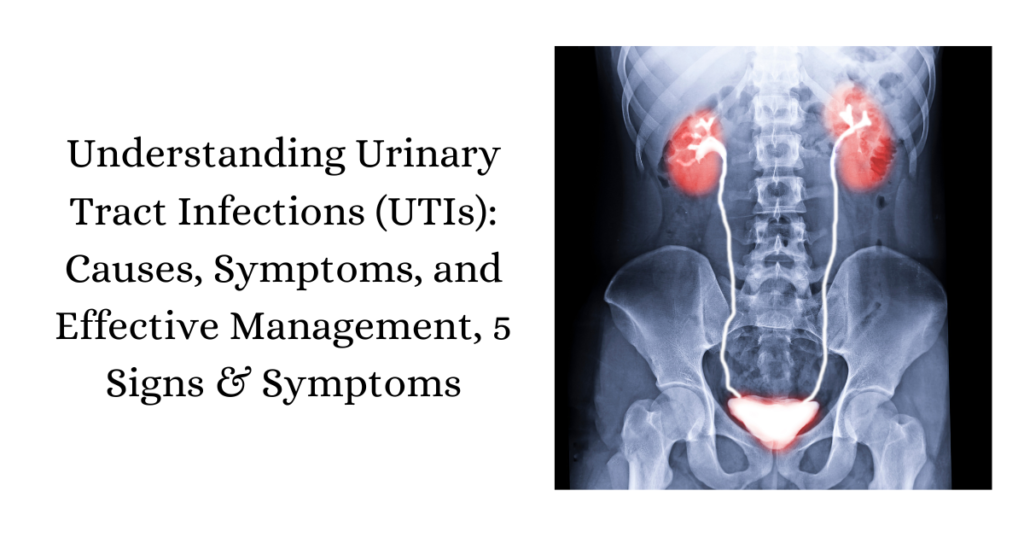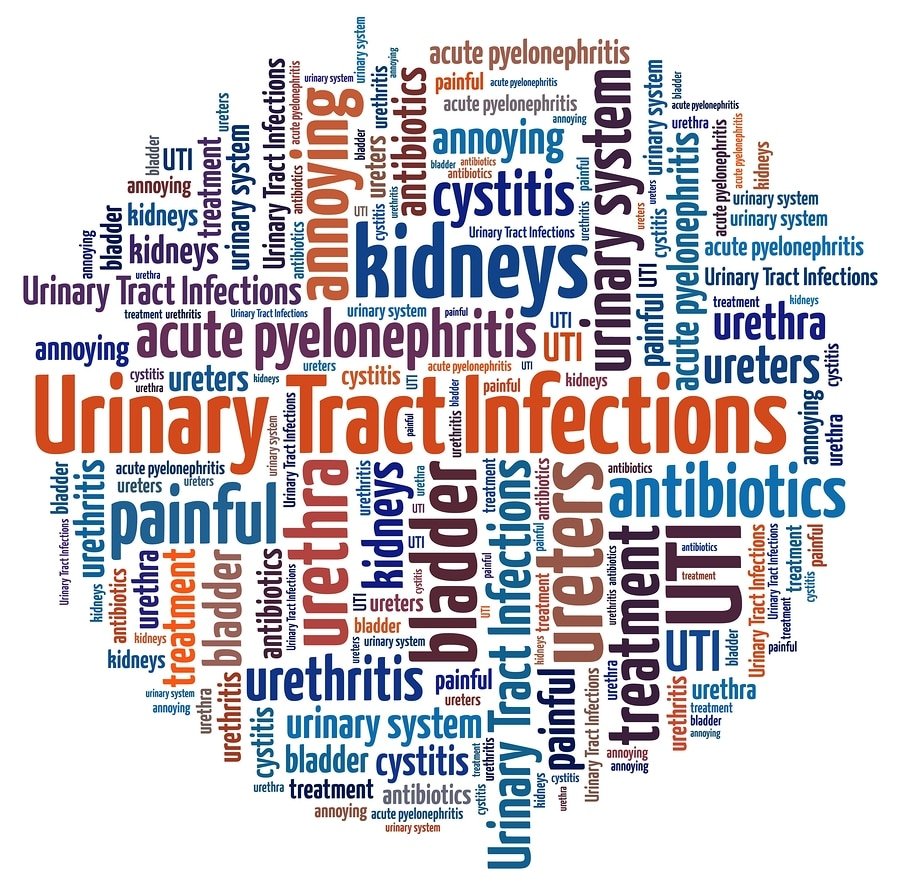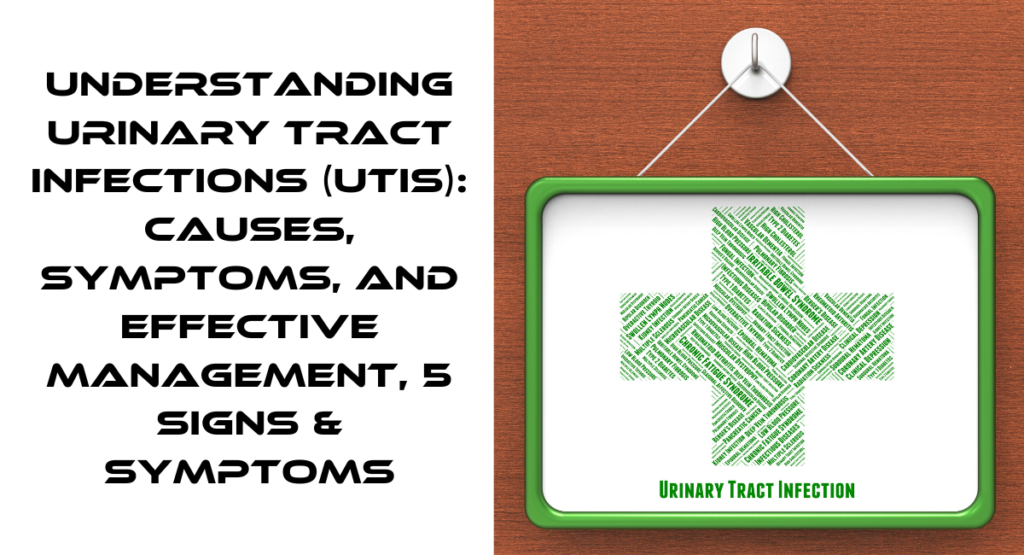Understanding Urinary Tract Infections (UTIs): Causes, Symptoms, and Effective Management, 5 Signs & Symptoms
Urinary Tract Infections (UTIs) are common bacterial infections that affect the urinary system, comprising the kidneys, bladder, ureters, and urethra. This article provides insights into the causes, symptoms, and effective management of UTIs, shedding light on these prevalent and often uncomfortable conditions.

1. Introduction to UTIs
Urinary Tract Infections occur when bacteria, primarily Escherichia coli (E. coli), enter the urinary tract and multiply, leading to an infection. While UTIs can affect any part of the urinary system, most cases involve the lower urinary tract, which includes the bladder and urethra.

2. Common Causes of UTIs
1. Bacterial Infection
The majority of UTIs are caused by bacteria, with E. coli being the most common culprit. Other bacteria such as Klebsiella, Proteus, and Staphylococcus can also lead to UTIs.
2. Contamination
Bacteria can enter the urinary tract through the urethra, often due to improper wiping after using the toilet, sexual activity, or the use of catheters.

3. Symptoms of UTIs
1. Painful Urination
A hallmark symptom of UTIs is a burning or painful sensation during urination, known as dysuria.
2. Frequent Urge to Urinate
Individuals with UTIs often experience a frequent and urgent need to urinate, even if only small amounts are expelled.
3. Cloudy or Strong-Smelling Urine
Changes in the appearance and odor of urine, such as cloudiness or a strong smell, can indicate a UTI.
4. Lower Abdominal Pain
Discomfort or pain in the lower abdomen is common, often signaling inflammation in the bladder.
5. Blood in Urine
Hematuria, or blood in the urine, may occur in more severe cases of UTIs.

4. Management and Treatment
Antibiotics
The primary treatment for UTIs involves a course of antibiotics prescribed by a healthcare professional. It is crucial to complete the entire antibiotic course, even if symptoms improve before completion.
Increased Fluid Intake
Drinking plenty of water helps flush out bacteria from the urinary tract and promotes recovery.
Pain Relievers
Over-the-counter pain relievers, such as acetaminophen or ibuprofen, can provide relief from pain and discomfort.
Avoiding Irritants
Limiting the consumption of irritants, such as caffeine, alcohol, and spicy foods, can alleviate symptoms.

5. Prevention Strategies
Stay Hydrated
Maintaining adequate hydration supports urinary health by promoting frequent urination, which helps flush out bacteria.
Urinate Promptly
Avoid delaying urination when you feel the need, as this minimizes the risk of bacteria multiplying in the urinary tract.
Wipe Properly
For females, wiping from front to back after using the toilet helps prevent the introduction of bacteria into the urethra.
Urinate After Sexual Activity
Emptying the bladder after sexual activity can help eliminate any bacteria that may have entered the urinary tract.
6. Conclusion
In conclusion, UTIs are common bacterial infections that can cause discomfort and inconvenience. Understanding the causes, recognizing symptoms, and adopting effective prevention and management strategies are crucial for individuals seeking relief from UTIs. Seeking prompt medical attention and following preventive measures can contribute to maintaining urinary health.
FAQs:
1. Can UTIs be caused by viruses or fungi?
– No, UTIs are primarily caused by bacteria, with Escherichia coli being the most common culprit. Viruses and fungi are not typical causes of urinary tract infections.
2. Are UTIs more common in women than men?
– Yes, UTIs are more common in women due to the shorter urethra, which allows bacteria easier access to the bladder. However, men can also experience UTIs, especially as they age.
3. Can UTIs resolve on their own without antibiotics?
– While some mild UTIs may resolve on their own, it is generally recommended to seek medical attention and receive a proper course of antibiotics to prevent the infection from spreading to the kidneys or causing complications.
4. Are cranberry products effective in preventing UTIs?
– Some studies suggest that cranberry products may help prevent UTIs by inhibiting bacteria from adhering to the urinary tract lining. However, more research is needed to establish their effectiveness conclusively.
5. Can UTIs recur frequently?
– Yes, some individuals may experience recurrent UTIs. Effective preventive measures, such as staying hydrated, proper hygiene practices, and prompt treatment of symptoms, can help reduce the likelihood of recurrent infections.
- https://en.wikipedia.org/wiki/Urinary_system
- Geostatistical Infection Mapping: Unveiling Patterns and Insights
- Viral Infection: Types, Causes, Signs and Symptoms, Prevention, and Treatment
- Types of H1N1 Viruses: Unraveling the Influenza A Variants
- H2N2: Signs and Symptoms, Causes, Prevention, and Treatments






